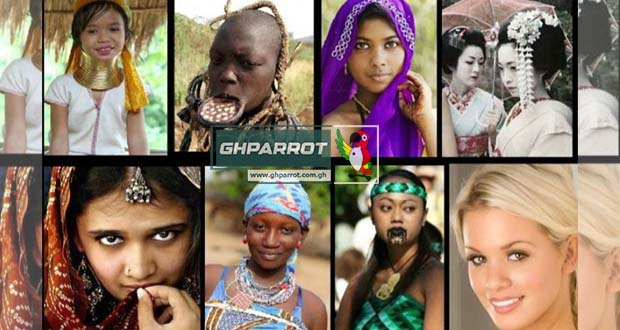How Culture Shapes What We Call Beautiful
A Comparative Look at African & Global Beauty Ideals

Beauty is one of the most universal yet culturally specific concepts in the world. Every society; African, Asian, European, American, and Indigenous has its own standards of what it means to be beautiful. These standards are not random. They emerged from history, identity, environment, survival, social values, and even politics.
Recommended: 5 Common Diseases Among the Elderly and How to Prevent Them
Understanding how beauty is shaped helps us appreciate diversity and challenge the narrow “global” beauty template often pushed by media and “wannabees”.
Below is an in-depth look at how culture defines beauty. Especially comparing African beauty to global beauty standards.
1. Beauty Isn’t Universal, It’s Cultural
Beauty feels natural, but it is a learned perception. What one culture celebrates, another may overlook.
For example:
In some African cultures, fuller bodies symbolize wealth, health, and fertility.
In the West, for decades beauty meant thinness, sharp features, and alignment.
In some Asian cultures, lighter skin has been associated with status, influencing modern beauty industries which is driving sales for companies and also causing long term health conditions.
This shows that beauty is less about biology and more about shared cultural meaning.
2. African Beauty: Identity, Heritage, and Symbolism
a. Body as a Story of Identity
African beauty is deeply connected to identity, culture, and community. Historically, beauty expressed:
Strength (broad hips symbolizing fertility)
Resilience (scarification showing bravery)
Status (hairstyles showing tribe or lineage)
Wealth (body shape indicating abundance)
African beauty celebrates presence, not invisibility. So features like:
curvier bodies
brown to dark skin tones
textured kinky hair
broad noses, full lips
were traditionally valued and celebrated.
b. Hairstyles as Cultural Language
African hair is not just aesthetic, it is cultural communication.
Braids, cornrows, and locs historically indicated:
age
family background
social status
spirituality
Modern Africans continue this legacy through:
protective styles
natural hair movement
braiding patterns with symbolic meaning
c. Skin Tone & the Colonial Influence
Before colonialism, darker skin was not stigmatized.
Post-colonial influence introduced:
skin bleaching
preference for lighter tones
Eurocentric facial ideals
However, Africa is witnessing a rebirth of melanin pride, rejecting colonial beauty residue.
3. Global Beauty Ideals and the Power of Media
a. Western Beauty Dominance
For decades, Western media defined the global beauty template:
slim bodies
straight hair
lighter skin
narrow noses
symmetrical features
minimal curves
Hollywood, fashion magazines, Barbie dolls, and pop culture exported this ideal worldwide, shaping how many people perceive beauty, even in cultures where those features are rare.
b. Globalization and the “One-Size-Fits-All” Beauty
Through the internet, global beauty trends travel fast:
contouring
filler lips
BBL body shapes
glass-skin look
filtered perfection
This creates pressure for people to fit into a single mold, even if it contradicts their natural features or cultural identity.
4. African Beauty vs Global Beauty: A Comparative Breakdown
| Aspect | African Beauty Ideals | Global/Western Dominant Ideals |
|---|---|---|
| Body Type | Curvy, fuller, strong, symbolizing health & fertility | Slim, toned, model-like physique |
| Skin Tone | Brown to dark tones celebrated traditionally | Lighter skin historically preferred |
| Hair | Kinky, coily, braids, locs, expressive cultural styles | Straight, wavy, chemically altered |
| Facial Features | Full lips, broad nose, high cheekbones | Narrow nose, small lips, high symmetry |
| Beauty Philosophy | Communal, symbolic, identity-based | Individualistic, aesthetic-based |
| Representation | Traditionally varied | Dominated by Eurocentric visuals |
5. The Modern Shift: African Beauty Going Global
In recent years, African beauty has become part of global conversation:
a. Afrocentric features are gaining recognition
fuller lips are now mainstream
curvy bodies are celebrated
natural hair is trending
dark-skin models dominate runways
African beauty is no longer “alternative”, it is influencing global aesthetics.
b. African models rising
Models like:
Adut Akech
Duckie Thot
Nyakim Gatwech
Naomi Campbell (earlier influence)
represent a shift toward embracing African features as globally aspirational.
c. African beauty industries booming
The rise of:
shea butter skincare
natural hair products
African fashion designers
melanin-focused cosmetics
shows Africa exporting beauty instead of importing beauty ideals.
6. How Environment Shapes Beauty Preferences
Beauty standards often emerge from an environment:
Hot climates → darker skin for protection
Agricultural societies → value for strong, fuller bodies
Urban, industrial societies → preference for slimness
Environmental demands create aesthetic preferences over time.
7. The Psychology Behind Beauty Standards
Beauty often symbolises:
survival
fertility
social status
wealth
belonging
For example:
Being curvy in African societies meant access to food → symbol of wealth
Being pale in some Asian societies meant not working under the sun → symbol of nobility
Being slim in modern Western societies suggests discipline in fast-food rich environments
Beauty is coded survival.
8. Why Beauty Standards Change
Beauty is dynamic. It shifts based on:
politics
economics
media representation
technological access
feminist movements
self-love trends
African beauty is rising because Africans are:
telling their own stories
controlling their media
building their fashion and beauty industries
rejecting external definitions
There is no single definition of beauty. Beauty Is Cultural, Not Universal. What is considered beautiful in Accra may differ from New York, Tokyo, or Paris. But today, African beauty is reclaiming its powerful, diverse, unapologetic, and globally influential place.
The future of beauty may finally become what it was always meant to be: a celebration of global diversity, not global conformity.



